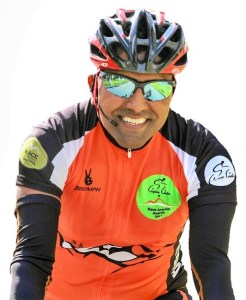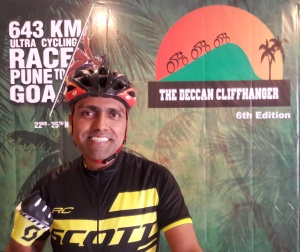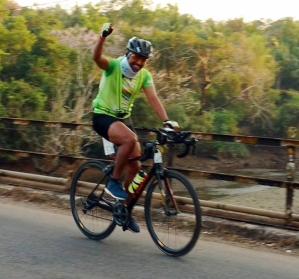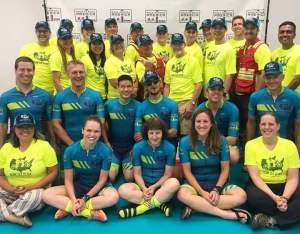For years, Lt Col Bharat Pannu lived a bland life. Then he discovered cycling, enjoying in particular the challenge of cycling long distances. A 2016 transfer to Nashik fueled the passion further. His progression in the sport has been rapid. In 2019, he will attempt Race Across America (RAAM).
There’s a story Bharat Pannu told.
In 2016, soon after shifting to Nashik he rushed to meet Col Srinivas Gokulnath, who had that year participated in Race Across America (RAAM). RAAM is a brutal test of endurance; it stuffs roughly 4800 kilometers of cycling – from the west coast of the US to the east with all accompanying geographical and climatic variations – into a requirement to cover the distance in a maximum of 12 days. Having heard of Srinivas, Bharat wanted to meet him. “ I considered myself a cyclist because of what I did in Jammu. So I introduced myself and expressed my desire to do something in the field of cycling. He asked me what my goal is. I thought a while and blurted out: Tour de France!’’
For Bharat, it had been a long ride to Jammu waiting for the universe to show him something he could excel at. His father Ram Mehar Singh retired as a subedar from the Indian Army; his mother Sarbati Devi is a homemaker. An only child, Bharat was born May 1982 in Julana in Haryana. As with children in army families, Bharat’s education happened across towns in India; wherever his father was posted to. There was Secunderabad, Tezpur, Pathankot, Ambala; by the time he reached Pune, Bharat was studying mechanical engineering at the Army Institute of Technology. “ Throughout I was the typical good student, as defined in India. It was all about being good at studies and very little, practically no sports,’’ he said. Sole exception was a work-out that manifested as related requirement. School students in India avail tuitions in addition to regular study at school. Although minors in age, they too end up commuting like their office going-parents, traveling from one location of study to the next. In country measuring itself more and more by the capacity to afford, this is the stage when life is about you and a bicycle. Later, most people won’t sit on anything less than an engine. Bharat sometimes covered 30-40 kilometers on his bicycle – a Hero Ranger Gen X – linking the dots that were school, tuition classes and home.
Once he completed his engineering in Pune, he worked for a very brief while at Forbes Marshall, a company in the city. Then, a project he had been on for quite some time, bore fruit. Seeking to join the army, he had earlier taken the admission test for the National Defence Academy (NDA) multiple times and been rejected every time at the interview stage. Through college, he had therefore kept himself involved in activities that may improve his skills to communicate and interact. A couple of months into his first job, he got his call letter from the army and moved to join the Indian Military Academy (IMA) in Dehradun. Here too, as in school, he wasn’t a cadet particularly competent at sports. He did his expected share of participating in games and physical training, wherein luckily, one strong point graced him – he turned out to be a good runner. “ In the army, there is a saying that if you are good at running then you are good at everything,’’ Bharat said. On June 10, 2006, he was commissioned as an officer in the army’s Corps of Electronics and Mechanical Engineers (EME).
Bharat’s first posting in the army was a stint at high altitude, in Sikkim. From there he moved to Arunachal Pradesh. Given altitude, sport for recreation was mostly chess, carom and volleyball, the last mentioned, viable only in summer months. In 2008, he was posted to Hissar in Haryana and after close to two years there, in 2010, was posted to Leh in Ladakh. From Leh, Bharat shifted to Secunderabad where he did his advanced course in aeronautical engineering. His job profile now altered to helping take care of the army’s aviation assets. All this time, Bharat’s appetite for physical activity was limited to what was compulsory under army rules – mainly the daily games parade, when officers and soldiers played together for bonding and team building. Plus he kept up that regular running, at times leading his unit to wins at cross country competitions. From Secunderabad, the army posted him to Bareilly and eventually, Jammu. His life began changing. There was a sports complex near where he stayed in Jammu. Bharat joined his colleagues to play badminton. “ Sports became a matter of interest for me in Jammu. It started with badminton. Then upon seeing others cycling, I bought a Raleigh MTB and joined them. Our camp was at Nagrota and we had good roads with rolling terrain in the vicinity. Probably because of my running, I seemed to do well in cycling too. All my rides were with colleagues from the army. Interaction with civilians has been little for me. The army is a self-contained ecosystem,’’ Bharat said.
In September 2016, he was transferred to Nashik, home to the Combat Army Aviation Training School. Within days he was before Srinivas. According to Bharat, Srinivas – he knew well the hard work required to be cyclist in the proper sense – asked him how much he cycled. Bharat replied: about 100 kilometers a week. Srinivas encouraged him to cycle more; he recommended BRMs. Bharat promptly registered for one, a move that also brought him in touch with Dr Mahendra Mahajan, who with his elder brother Dr Hitendra Mahajan, had been the first Indians to complete RAAM (as two person team) in 2015. It is a bit difficult putting in perspective what drove Bharat to commit himself so to cycling. He reckons that Jammu was some sort of a late awakening in sports for him. He also admits to craving for some of the recognition that visits people accomplishing things in life. Cycling appeared a path opening up; he grabbed it. Bharat joined duty in Nashik on September 8. By October 28, he had spent over Rs 150,000 and acquired a Trek Emonda S6 road bike. “ I was in no frame of mind to stop myself,’’ he said.
That November – he had taken leave the whole month to use up the holidays he hadn’t availed – Bharat cycled to Pune. It was November 5. Within the first 10 kilometers he got his first puncture. He replaced the affected tube with a spare one and carried on. Roughly 60-70 kilometers before Pune, he got his second puncture, which he repaired himself. November 6, he rested in Pune. The next day, he returned to Nashik. By now he was part of the city’s BRM group and nursing dreams of becoming a super randonneur (completing 200, 300, 400 and 600 kilometer-brevets in a year). One day after he texted seeking company for a ride to Trimbakeshwar, Darshan Dubey responded. It was the beginning of a solid friendship; Darshan, the more experienced cyclist of the two. Born 1989, Darshan grew up in Nashik. His curiosity for distance cycling was prompted by a 2014 magazine article by the Mahajan brothers on their experiences in cycling; Hitendra had written about Tour of the Dragons in Bhutan and Mahendra had written about his BRMs. “ I read that and thought maybe I too can do something,’’ Darshan said. He bought a Hercules Atom steel frame bike and for a while struggled doing long rides on the heavy cycle with no proper bicycle gear and apparel. A visit to Decathlon – the sports goods retailer – eased the apparel issue and helped extend the distances he covered. Then he stumbled on GCN network on the Internet. It showed him the predicament he had got himself into – there was more to bicycle than just buying one; there was intended application and bike suited for it, there was bike geometry, there was bike sizing. By now, he had also got to know a group called Nashik Cyclists. Although his parents were skeptical about upgrading, Darshan managed to buy a Montra Unplugged 1.1 road bike; it was the cheapest Montra road bike and had a seven speed-cassette behind. Then a move to crowded Mumbai for higher studies put the brakes on cycling. “ Still I cycled whenever I could,’’ Darshan said. In January 2016, he did a 300 kilometer-brevet; Mumbai-Pune-Mumbai.
In October, he was visiting Nashik when Bharat’s text landed in local brevet circles. “ I responded not knowing a thing about Bharat. That’s how it is in cycling, that’s how you meet new people,’’ Darshan said. Also joining in for the ride to Trimbakeshwar was Venugopal Nair, Nashik based-cyclist who had done a bunch of brevets. Not long after Darshan returned to Mumbai after the Trimbakeshwar ride, he got a call from Bharat about an upcoming 300 kilometer-BRM from Dhule to Nashik and back. BRMs are not races. On that outing, Bharat was the first rider to report back to Dhule after completing the route. According to Darshan, the organizers and riders complimented Bharat. Being from the army, he had the endurance required for long rides. All he needed was being comfortable on the saddle for long durations. Darshan remarked that Bharat should face no problem completing Deccan Cliffhanger (DC), the annual race on the Pune-Goa route which also serves as RAAM qualifier (RQ). Darshan had crewed earlier for a cyclist at DC. Bharat added DC to his list of things to do, while in Nashik. The 300 kilometer-BRM was followed by a 200 kilometer-BRM on November 20 – it was Nashik–Saputara-Nashik – which Bharat completed successfully within stipulated time. A week later, on November 27, he did a 300 kilometer-BRM – Pune-Mahabaleshwar-Satara-Pune. November 2016 was a month of getting BRMs done. A stroke of luck in taking leave right then was that it was a convenient month for Darshan too. At that time, Darshan was pursuing his MBA from Wellingkar Institute in Mumbai. November suited him to join Bharat on rides. “ I got a good friend in Darshan, someone more motivated than I to ride. He was the force taking me ahead,’’ Bharat said. Post November, the routine of office returned and with it; although weekly mileage had clearly risen, Bharat’s regular riding was mostly Nashik to Trimbakeshwar and back.
Around December 15, Bharat got a call from Darshan informing that Divya Tate of Inspire India was organizing a new race in January 2017 – Ultra Spice from Goa to Ooty and back – with three distance categories of 500, 1000 and 1750 kilometers and RQ to boot. Bharat estimated he was probably ready for 500 kilometers. Darshan agreed to take care of securing support crew. Later they shifted to 1000 kilometer-category because the 500 kilometer-race wasn’t assigned RQ. According to Bharat, there were only three participants in Ultra Spice that year, one in each distance category (the rider for 500 kilometers did not turn up on race day). The pre-race briefing was therefore a chat across a table. It was Bharat’s first race with support crew and he had no idea yet of what the race entailed; he had no specific strategy or nutrition plan in place. “ When Divya asked me about my race strategy at the briefing table, I had that old Tour de France-look on my face. It must have worried her for besides my personal safety she had a race’s reputation to protect,’’ Bharat said laughing. In his mind, Darshan who was anchoring Bharat’s crew, felt 1000 kilometers was ambitious. “ I was keeping my fingers crossed,’’ he said. However Bharat went on to complete the 1000 kilometer-course in 55 hours, 35 minutes with less than two hours of sleep en route. It was RQ; he was the only finisher in this first edition of the race. In retrospect, he admitted, what he did exposed the novice in him – ideally, it should be adequate sleep, recover, proper nutrition and let the body deliver. Following Ultra Spice, Bharat believes, he started to be taken a bit more seriously in cycling. He explained it so – cycling circles perceived him as rider who accomplished RQ at Ultra Spice despite no proper strategy and nutrition plan. So what would it be like if he had those in place? It hinted of potential. His cyclist friends in Nashik became even more supportive. “ After this race, a new chapter commenced,’’ Bharat said. He began thinking of attempting an ultra-cycling event outside India. Once again, the fuel driving it was need for recognition; achievements within the country are not as celebrated as those outside. He was candid in admitting that.

From Race Around Austria; cyclist is visible as small speck on the road in the left half of the picture (Photo: courtesy Bharat Pannu)
Some months earlier, in August 2016, Ammar Miyaji from Nashik had attempted Race Around Austria (RAA). RAA is not as long as RAAM but within its compact proportion of a ride along the perimeter of Austria, it packs a punch with steep roads and sizable elevation gain. Divya had been part of Ammar’s crew for RAA. The original idea, Darshan said, was for Bharat to attempt RAA’s 1500 kilometer-race, which was RQ and open only to solo riders. But when they approached Chaitanya Velhal to be coach, Chaitanya was skeptical. Not one to back off, Bharat came up with the suggestion that he and Darshan attempt RAA’s 2200 kilometer-race as two-person team. Lacking comprehension of how such a team works, they consulted Dr Mahendra Mahajan. He explained the process and also recommended that they get a coach. The schedule was tight. The duo decided in March, met Mahendra in April and the race was due in August. At their request, Divya came aboard as crew chief. Chaitanya joined as coach. Of the three months available, Chaitanya effectively had two for use. July being a month of rain would be wash-out. Divya’s challenges included finding crew members who spoke German because local knowledge and ability to engage when needed are always helpful. But most important was finding someone in Austria who would make the team feel comfortable on the ground.
On Strava, Darshan found the Moshammer family residing in St Georgen Im Attergau, where RAA starts. Having done RAA himself, Hannes Moshammer helped with valuable tips besides hosting the team at his house once they reached Austria. The race route was along the countryside. To practise for RAA’s steep climbs, Bharat had relied on the gradients around Nashik. Darashan, having been transferred to Bengaluru on work, had a tougher time. Exiting Bengaluru’s urban congestion and finding space for practice is itself time consuming. As for bikes, Bharat took his Trek Emonda fitted with new wheels for improved rolling; Darshan had his Fuji SL 2.3 (a carbon frame bike, he had used it at the Dhule-Nashik BRM). Gear ratios on both bikes were altered to suit climbing. Ahead of race, the two cyclists rode up the last of RAA’s nine mountain passes. “ Not one instance of hill training we did in India was comparable to the climbs we faced,’’ Bharat said. The highest elevation in RAA was only 12,800 feet. But the roads connecting these heights had gradients more severe than what Indian roads did. As race progressed, the Moshammer family tracked the team on a daily basis. Austria is a small country. Every day, the family drove from where they stayed to some point on the route and cheered the Indians as they cycled past. Between Darshan and Bharat, they had set a goal of completing RAA in 100 hours. At the 86th hour, they were left with roughly 350 kilometers to complete. They motivated themselves and got the race wrapped up in 99 hours, 53 minutes. Race cut-off was 108 hours. “ We finished fifth in the two-person category,’’ Bharat said. Post RAA, the cyclists got a rousing welcome in Nashik. Bharat was also commended by the army. Among those who attended the awards ceremony at RAA’s close had been Christoph Strasser, Austrian ultra-cyclist and five time winner and record holder at RAAM.
Back from RAA, Bharat trained for the January 2018 edition of Ultra Spice and completed it. He had issues with his bike; he also suffered neck pain. “ Despite being competitor, Kabir Rachure looked out for me on this race,’’ Bharat said. On completing Ultra Spice, Bharat was firmly resolved that he should attempt RAAM. In February, he made up his mind to enroll for the race. But there was one thing to do before formally participating in RAAM as rider. He required getting a sense of the route and seeing, firsthand, what riders endured traversing the breadth of the US.
Bharat wrote to teams attempting RAAM in 2018 for berth as crew member. Team Sea to See responded positively. Dedicated to proving that those who are blind can succeed in any field, they envisaged combination of one visually challenged rider and one with normal eyesight cycling together on tandem bikes. The team had eight cyclists participating. Bharat was accepted as navigator. “ Going with a team is better as chances of completion are higher. You get to see the whole RAAM route,’’ Bharat said. The team – Bharat included as navigator – completed 2018 RAAM successfully. “ Team Sea to See was a very good learning experience,’’ he said. Now it was time for Bharat to focus on his own preparations for attempting the race solo in 2019.
At his house in Nashik, to a side in Bharat’s room was a Scott road bike mounted on a trainer. It was one of three bikes acquired recently – a Scott Foil 20 and two Scott Addict 10; the former for flats, the latter for climbs. Below, on the ground floor of the house, was a wooden chest of drawers with rack on top holding three bikes; one of them being his old road bike. The chest contained bicycle accessories and tools. Bharat’s parents stay with him. “ Had it not been for their presence here, I wouldn’t be able to live as I do,’’ he said. For a long time, his parents didn’t know exactly what he was doing, disappearing every now and then with his bicycle. The turning point was RAA. Some days before leaving for Austria, he had to tell them what was underway. Now they are aware of his fascination for cycling. Ram Mehar Singh hasn’t yet crewed for his son but he hoped to be at a race one day. Sarbati Devi is set to be part of Bharat’s crew for RAAM. She will handle food in the run up to RAAM (Bharat will reach US about a month before the race to train and get used to the weather there) and once race starts, she will be in one of the support vehicles preparing homemade food for her son. Darshan too is headed for the US as part of Bharat’s RAAM crew.
It was close to midnight, November 12, 2018. Bharat – now a Lieutenant Colonel – had just returned from a party at his friend’s house. He was expected to continue the conversation with this blog from where he had left off ahead of party. But with work, cycling, training at the gym and socializing – all going on, he was tired; early next morning seemed better option to chat. That was when Tracy called. It was night in Nashik; daytime in the US. Until some months ago, Bharat had been training under Mumbai-based cycling coach, Miten Thakker. However Miten was unsure whether he would be able to accompany Bharat to the US for RAAM. So in April 2018, Tracy McKay entered the picture. They met on Facebook. Tracy had completed RAAM in 2002 as part of a two-person team (they took eight days, three hours, placing second overall). In 2004, he made an unsuccessful solo attempt. In 2005, he was team strategist / crew chief for Chris MacDonald who cycled solo and finished second overall besides winning Rookie of The Year.
Based in Birmingham, Alabama, Tracy took on the role of Bharat’s coach and crew chief for RAAM. In a brief email exchange, Tracy outlined the challenges in RAAM. An event of this dimension will see participant running after many things. Among the first challenges therefore would be getting distracted from the main task of training and preparing. “ Much time can be taken in publicity and marketing by rider. Someone must take charge of this while rider prepares…sleep, ride, sleep, ride, sleep, ride – it slowly becomes a full time job outside of what they currently do,’’ he said. Then there are the physiological challenges posed by terrain and weather during RAAM. For example, in the desert the heat must be mitigated with IV fluids and there should be a strategy on when to ride. However what makes RAAM what it is, is the mental test and introspection it throws up. While the brain is designed to keep us away from harm and pain, each pedal stroke in ultra-cycling moves rider closer to discomfort till it builds up to a level you didn’t expect. You prepared, sacrificed, friends and family are invested in you – and then RAAM brings its reality. “ There is a great deal of self-examination, self-doubt. It becomes a roller coaster; it becomes a roller coaster for the crew. There will be moments where you want to quit, where the crew may even support it. But it is not required. Everyone must understand that this is the unexpected part of RAAM you must prepare for,’’ he said. As for any benefit in RAAM aspirant having done RAA before, he said, RAA can be compared only to other races of similar distance. RAAM is much longer. There can be no comparison between the two. Asked if there is any “best’’ personal quality or trait that a rider can bring to RAAM, he said a single quality won’t suffice. Self-concept / humility, sense of humor, ability to fail and try again (not out of vanity but from what you learnt from failing) and detachment – these may help, Tracy said.
Some weeks before I met Bharat, the 2018 Deccan Cliffhanger occurred. Bharat completed it successfully in 26 hours, five minutes. At the time of writing, Bharat had Tracy’s instructions to follow, Ultra Spice (1750 kilometer-category) to tackle in January and thereafter, by mid-2019, RAAM in the US.
Update: News reports of January 30, 2019 said that Lt Col Bharat Pannu completed the 1750 kilometer-category of 2019 Ultra Spice (an annual ultra-cycling event organized by Inspire India, from Goa to Ooty and back) in record time of 95 hours. This is an improvement over the previous record of 98 hours held by Col Srinivas Gokulnath.
(The author, Shyam G Menon, is a freelance journalist based in Mumbai.)












